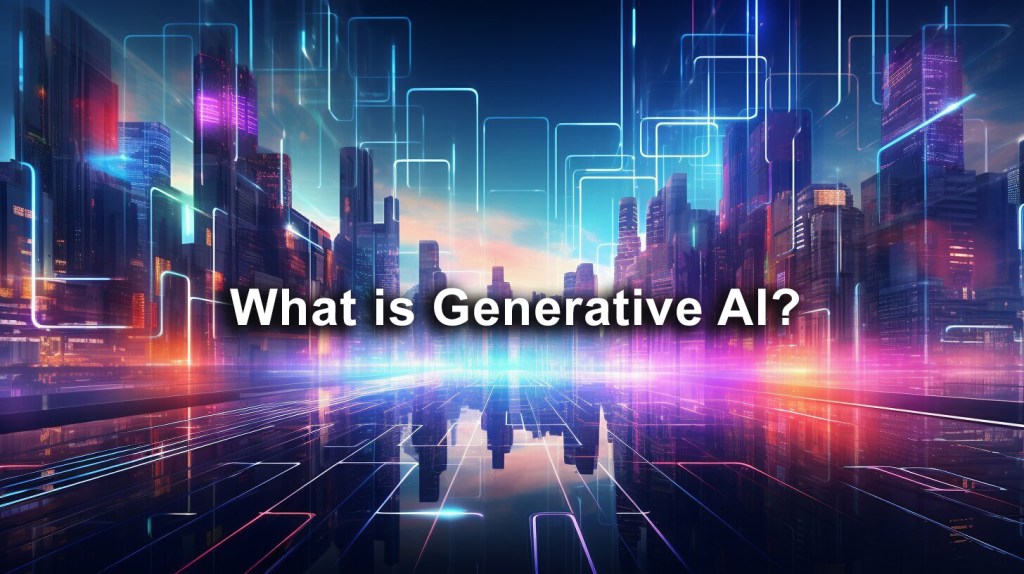Updated: Oct 11, 2023 By: Dessign Team

Generative AI is a groundbreaking technology that utilizes advanced algorithms to analyze data, identify patterns, and generate new content or solutions, revolutionizing various industries. With its transformative potential, generative AI is reshaping the way we approach artificial intelligence, machine learning, and deep learning.
By harnessing powerful algorithms, generative AI can interpret open-ended human commands, write, code, brainstorm, and remix ideas or skills demonstrated by humans on the internet. This technology has the capacity to interpret and understand context, allowing it to create innovative and meaningful content.
Generative AI has already made significant strides in industries such as real estate, healthcare, finance, manufacturing, retail, enterprise, energy, and travel. Its ability to analyze vast amounts of data and generate insights has transformed decision-making processes and improved efficiency across these sectors.
Key Takeaways:
- Generative AI utilizes advanced algorithms to analyze data and generate new content or solutions.
- It has the potential to revolutionize various industries, including real estate, healthcare, finance, manufacturing, retail, enterprise, energy, and travel.
- Generative AI can interpret open-ended human commands, write, code, brainstorm, and remix ideas or skills demonstrated by humans on the internet.
- Businesses are leveraging generative AI to boost productivity by streamlining information gathering and synthesis processes.
- However, there are limitations and risks associated with generative AI, such as flawed logic and recall, unexpected failure in reasoning, and potential risks to cybersecurity, copyright infringement, and defamation.
The Capabilities of Generative AI
Generative AI encompasses a wide range of capabilities, such as natural language processing, computer vision, and the utilization of probabilistic models to interpret human commands and generate relevant content or solutions. This groundbreaking technology has the ability to understand and analyze vast quantities of data, unlocking new possibilities across various industries.
With natural language processing, generative AI can interpret open-ended human commands and generate written content that mimics human-like speech patterns. By leveraging this capability, businesses can automate tasks such as writing product descriptions, customer interactions, or even creative storytelling.
Furthermore, generative AI’s computer vision capabilities empower machines to understand and interpret visual data, allowing them to analyze and generate content based on images or videos. This can be particularly valuable in fields such as healthcare, where generative AI can aid in diagnosing medical conditions by analyzing medical images or provide virtual tours in the real estate industry by generating virtual 3D models.
Probabilistic models form another critical component of generative AI. By modeling uncertainties and incorporating prior knowledge, these models allow machines to generate content or solutions that align with statistical patterns and decision-making processes. Through the power of generative AI, businesses can automate tasks such as data analysis, pattern recognition, and content generation, driving efficiency and innovation.

The Role of Machine Learning and Deep Learning
Machine learning and deep learning play a crucial role in generative AI, with neural networks being used to train algorithms and facilitate the generation of unique and innovative content. By leveraging these powerful techniques, generative AI systems are able to analyze vast amounts of data and learn from patterns, enabling them to generate new content or solutions.
One of the key advantages of machine learning in generative AI is its ability to recognize and understand complex patterns in data. Deep learning, a subset of machine learning, utilizes artificial neural networks to simulate the human brain’s neural connections and processing. This enables generative AI systems to interpret and analyze data in a similar way to how humans do, allowing them to generate content or solutions that are both relevant and contextually accurate.
Neural networks in generative AI act as the backbone for training algorithms. These networks consist of interconnected layers of nodes, or artificial neurons, that process and transmit information. Through an iterative process known as training, the neural network learns from labeled data, adjusting its internal parameters to improve its performance over time. This training process enables the generative AI system to generate high-quality, contextually relevant content based on the patterns it has learned.
The Power of Neural Networks in Generative AI
Neural networks in generative AI bring immense power and potential. They enable the generation of innovative content, such as text, images, or even entire websites, based on patterns and insights derived from vast amounts of data. The neural network-driven approach allows generative AI to go beyond traditional programming methods, opening up possibilities for creative and adaptive content generation.
Furthermore, neural networks in generative AI can be fine-tuned and optimized to produce specific types of content or solutions. By adjusting the network architecture, training parameters, and input data, developers can shape the output of the generative AI system to meet their specific requirements. This flexibility makes generative AI a versatile tool that can be applied across a wide range of industries and use cases.
| Generative AI Applications | Industry |
|---|---|
| Automated content generation | Media and publishing |
| Virtual assistants | Customer service |
| Image and video synthesis | Entertainment |
| Drug discovery and development | Pharmaceuticals |
| Financial forecasting | Finance |
As machine learning and deep learning continue to advance, so does the potential of generative AI. With neural networks at its core, generative AI unlocks new levels of creativity, efficiency, and innovation, making it a valuable tool for businesses across industries.

Generative AI has the power to transform industries such as real estate, healthcare, finance, manufacturing, retail, enterprise, energy, and travel, offering innovative applications and significant benefits. In the real estate sector, generative AI can analyze market trends and historical data to generate accurate property valuations, helping buyers and sellers make informed decisions. Healthcare providers can leverage generative AI to analyze patient data, identify patterns, and develop personalized treatment plans. In finance, generative AI can assist in risk modeling, fraud detection, and portfolio management, improving decision-making processes. Manufacturing companies can utilize generative AI to optimize production processes, minimize waste, and create custom designs.
Retailers can leverage generative AI to analyze customer preferences, predict trends, and enhance personalized shopping experiences. In the travel industry, generative AI can create customized itineraries based on user preferences, recommend destinations, and optimize travel routes. Enterprises across various sectors can benefit from generative AI’s ability to automate repetitive tasks, generate reports, and assist in decision-making processes. Energy companies can use generative AI to optimize energy consumption and improve sustainability practices.
Applications and Benefits of Generative AI in Various Industries:
| Industry | Applications | Benefits |
|---|---|---|
| Real Estate | Accurate property valuation, market analysis | Informed decision-making, improved efficiency |
| Healthcare | Personalized treatment plans, data analysis | Improved patient outcomes, enhanced efficiency |
| Finance | Risk modeling, fraud detection, portfolio management | Better decision-making, improved security |
| Manufacturing | Process optimization, custom design | Reduced waste, enhanced product quality |
| Retail | Customer analytics, trend prediction | Personalized experiences, increased sales |
| Enterprise | Automation, decision support | Increased productivity, improved efficiency |
| Energy | Energy optimization, sustainability | Reduced costs, improved environmental impact |
Generative AI has the potential to revolutionize these industries by enabling automation, improving efficiency, and enhancing decision-making processes. However, it is important to acknowledge and address the limitations and risks associated with generative AI. Flawed logic and recall, unexpected failure in reasoning, and the production of factually incorrect material are potential risks. Generative AI also poses cybersecurity risks, as well as the potential for copyright infringement and defamation. Companies must implement appropriate governance approaches, assess and manage these risks, and stay updated with evolving regulations to ensure responsible development and compliance.
Generative AI is a journey that requires ongoing experimentation and careful risk management. By embracing responsible development and governance, generative AI has the potential to be tremendously empowering and transformative for industries and society as a whole. It enables businesses to leverage data and technology to drive innovation, improve productivity, and deliver enhanced experiences to customers.
Boosting Productivity with Generative AI
Generative AI can significantly enhance productivity by streamlining information gathering and synthesis, providing businesses with efficient and effective solutions for data analysis and content creation. With the ability to analyze vast amounts of data and generate new content or solutions, generative AI offers a powerful tool for companies looking to improve their operations.
One way generative AI boosts productivity is by automating the process of information gathering. Instead of manually collecting data from various sources, generative AI algorithms can quickly extract relevant information from large datasets, saving businesses valuable time and resources. This enables companies to make informed decisions and gain insights at a much faster pace.
Streamlining Content Creation
Another area where generative AI excels is in content creation. Whether it’s generating written articles, designing visual content, or creating code, generative AI can assist businesses in producing high-quality content efficiently. By leveraging advanced algorithms and machine learning techniques, generative AI can understand human commands and generate content or solutions based on them. This not only saves time but also ensures consistency and accuracy in the generated output.

Generative AI can also enhance the synthesis of information by analyzing diverse datasets and generating comprehensive reports or summaries. This enables businesses to gain a holistic view of complex data and make well-informed decisions. With generative AI, the process of synthesizing information becomes faster, more accurate, and less prone to human error.
However, it’s important to note that while generative AI offers significant productivity benefits, there are also limitations and risks associated with its use. Flawed logic and recall, unexpected failures in reasoning, and the production of factually incorrect material are some of the risks that need to be carefully managed. Additionally, generative AI poses risks to cybersecurity, copyright infringement, and defamation. Companies must prioritize assessing these risks, developing appropriate governance approaches, and staying updated with evolving regulations to ensure responsible development and compliance.
In conclusion, generative AI has the potential to revolutionize productivity by streamlining information gathering and synthesis. By automating these processes, businesses can save time, improve decision-making, and enhance the quality of their output. However, it’s crucial for companies to proactively address the limitations and risks associated with generative AI and embrace responsible development. If managed effectively, generative AI can be tremendously empowering and transformative for industries and society as a whole.
Limitations and Risks of Generative AI
While generative AI holds immense potential, it is not without limitations and risks, including flawed logic, unexpected reasoning failures, and risks related to cybersecurity, copyright infringement, and defamation. These factors need to be carefully considered and managed in order to harness the full power of generative AI while mitigating potential pitfalls.
One of the primary limitations of generative AI lies in its ability to produce content with flawed logic or reasoning. Due to its reliance on algorithms and data patterns, generative AI may sometimes generate inaccurate or illogical information. This can have serious consequences, especially in industries where precision and accuracy are critical.
Additionally, generative AI systems may experience unexpected reasoning failures, leading to the production of factually incorrect material. This can be particularly concerning in sectors such as healthcare or finance, where incorrect information could have severe implications for individuals or organizations relying on the generated content.
Cybersecurity is another significant risk associated with generative AI. As these systems are designed to analyze and generate large amounts of data, they become attractive targets for malicious actors seeking to exploit vulnerabilities. Safeguarding generative AI systems against cyber threats should be a key priority for organizations implementing this technology.
| Type of Risk | Description |
|---|---|
| Cybersecurity | Ensuring the security of generative AI systems against malicious attacks. |
| Copyright Infringement | Preventing the unauthorized use or reproduction of copyrighted material by generative AI systems. |
| Defamation | Mitigating the risk of generative AI systems generating defamatory content that may harm individuals or organizations. |

“The potential risks associated with generative AI should not dampen the enthusiasm for its transformative capabilities. With responsible development and effective governance, these risks can be effectively managed and mitigated.” – Expert in AI Ethics
Governance and responsible development
To address these limitations and risks, governance and responsible development play a crucial role in the successful implementation of generative AI. Organizations need to establish robust risk assessment processes, ethical guidelines, and governance frameworks to ensure the responsible use of generative AI technology.
Furthermore, staying informed about evolving regulations is paramount, as governments are increasingly recognizing the need to regulate AI technologies. Organizations must actively monitor and adapt to changing legal requirements to ensure compliance and safeguard against potential legal repercussions.
While the limitations and risks associated with generative AI are real, they should not deter organizations from exploring the immense potential this technology offers. By deploying generative AI responsibly, businesses can unlock new opportunities, streamline processes, and drive innovation across various sectors.
It is crucial for organizations to approach generative AI as a journey that requires ongoing experimentation, risk management, and continuous learning. With a proactive approach to governance and responsible development, generative AI has the potential to be truly empowering and transformative, revolutionizing industries and shaping the future of our digital world.
Governance and Responsible Development
To ensure the responsible development of generative AI, companies need to prioritize governance, assess risks, and stay abreast of evolving regulations in the field. This is crucial in order to mitigate potential ethical concerns and ensure the technology is used for the greater good of society. As generative AI continues to advance and permeate various industries, it is essential for businesses to establish clear policies and guidelines that govern its use.
Governance frameworks should address issues such as data privacy, transparency, and accountability. Companies must carefully consider the ethical implications of generative AI and implement safeguards to prevent the creation and dissemination of harmful or misleading content. By taking a proactive approach to governance, businesses can build trust with their stakeholders and ensure that generative AI is deployed responsibly.
Assessing risks is another vital aspect of responsible development. Companies must identify potential pitfalls that could arise from the use of generative AI, including the risk of flawed logic, unexpected failure in reasoning, and the production of factually incorrect material. By understanding these risks, businesses can implement measures to mitigate them and minimize any negative impact.
Staying informed about evolving regulations is equally important. As the field of generative AI continues to evolve, regulatory frameworks are being developed to address its unique challenges. Companies must remain up to date with these regulations and adapt their practices accordingly. By doing so, businesses can ensure compliance and contribute to the responsible development of generative AI that benefits society as a whole.
The Role of Governance in Responsible Development
Governance plays a pivotal role in the responsible development of generative AI. It provides a framework for ethical decision-making and ensures that the technology is used in a manner that aligns with societal values. With effective governance, generative AI has the potential to be a powerful tool for innovation and advancement. However, without proper oversight, it can also pose risks.
By prioritizing governance, assessing risks, and staying informed about evolving regulations, companies can navigate the complex landscape of generative AI with confidence. This requires a collaborative effort between stakeholders, including policymakers, industry leaders, and the wider public. Together, we can shape the future of generative AI in a way that benefits everyone, while minimizing any potential harm.
| Risks | Measures |
|---|---|
| Flawed logic and reasoning | Regular testing and validation of generative AI algorithms |
| Production of factually incorrect material | Implementing fact-checking processes and filters |
| Risks to cybersecurity | Robust cybersecurity measures and encryption protocols |
| Copyright infringement | Clear guidelines on the use of copyrighted content |
| Defamation | Monitoring and moderation systems to prevent defamatory content |
By addressing these risks and implementing appropriate measures, companies can harness the transformative potential of generative AI while ensuring responsible development. It is an ongoing journey that requires continuous assessment and improvement, but the rewards are well worth the efforts.

Generative AI is an ongoing journey that involves experimentation and thoughtful risk management, enabling continuous exploration and learning to unlock its full potential. It is a groundbreaking technology that uses advanced algorithms to analyze data, identify patterns, and generate new content or solutions. By harnessing the power of generative AI, businesses can transform their operations and drive innovation in various industries.
Experimentation is a key aspect of the generative AI journey. It allows businesses to push the boundaries of what is possible and discover new applications for the technology. Through experimentation, companies can test different approaches, fine-tune algorithms, and optimize performance. This iterative process of trial and error is crucial for uncovering the true capabilities of generative AI.
“Experimentation is not about failure; it’s about gathering valuable insights and refining our understanding of generative AI.”
However, along this journey, it is important to manage risks effectively. As with any transformative technology, generative AI has its limitations and risks. Flawed logic and recall, unexpected failure in reasoning, and the production of factually incorrect material are among the potential pitfalls. Furthermore, generative AI poses risks to cybersecurity, copyright infringement, and defamation. To mitigate these risks, companies must establish governance frameworks, implement robust security measures, and ensure compliance with evolving regulations.
By balancing experimentation with risk management, businesses can navigate the journey of generative AI successfully. They can unlock the technology’s empowering and transformative potential, driving innovation, and revolutionizing industries. The path may be challenging, but with the right approach, generative AI can redefine how we work, create, and solve problems in the digital era.

When approached with governance and responsible development, generative AI holds the potential to be tremendously empowering and transformative, benefiting industries and society at large. By harnessing the power of advanced algorithms, generative AI enables businesses to analyze vast amounts of data, identify patterns, and generate innovative content or solutions.
One of the key benefits of generative AI is its ability to streamline information gathering and synthesis processes, thereby boosting productivity in various industries. With generative AI, businesses can automate data analysis, freeing up valuable time and resources that can be redirected towards strategic decision-making and innovation.
Generative AI has the potential to revolutionize content creation and problem-solving, enabling businesses to generate fresh ideas, creative concepts, and new solutions. It can complement human capabilities by interpreting open-ended commands and generating content or solutions based on them.
However, it is important to acknowledge the limitations and risks associated with generative AI. Flawed logic and recall, unexpected failure in reasoning, and the production of factually incorrect material are some of the challenges that need to be addressed. In addition, generative AI poses risks to cybersecurity, copyright infringement, and defamation. To mitigate these risks, companies must prioritize governance and responsible development, continuously assessing and managing the potential risks.
| Benefits of Generative AI | Risks of Generative AI |
|---|---|
|
|
As generative AI evolves and becomes more widespread, it is crucial for companies to establish effective governance approaches and stay updated with evolving regulations. By doing so, they can navigate the ethical and legal complexities associated with generative AI and ensure compliance with industry standards.
In conclusion, generative AI presents exciting opportunities for industries to unlock new levels of productivity and innovation. When governed and developed responsibly, generative AI has the potential to be transformative, empowering businesses and society as a whole. By harnessing the capabilities of generative AI while mitigating risks, companies can pave the way for a future where AI-driven solutions coexist harmoniously with human creativity and ingenuity.

In conclusion, generative AI is a groundbreaking technology with the potential to revolutionize industries, enhance productivity, and empower businesses, but it requires careful governance and responsible development to adapt and address associated risks.
Generative AI utilizes advanced algorithms to analyze data, identify patterns, and generate new content or solutions. Its transformative potential spans a wide range of sectors, including real estate, healthcare, finance, manufacturing, retail, enterprise, energy, and travel.
With the ability to interpret open-ended human commands, generative AI can write, code, brainstorm, and remix ideas or skills demonstrated by humans on the internet. This capability allows businesses to streamline their information gathering and synthesis processes, boosting productivity and efficiency.
However, it is important to recognize the limitations and risks of generative AI. Flawed logic and recall, unexpected failures in reasoning, and the production of factually incorrect material are some of the challenges that need to be addressed. Additionally, there are risks related to cybersecurity, copyright infringement, and defamation that must be managed and monitored.
To ensure compliance and responsible use of generative AI, companies need to assess risks, develop governance approaches, and stay informed about evolving regulations. By doing so, they can navigate the journey of generative AI, experiment with its capabilities, and maximize its empowering and transformative potential.
FAQ
What is generative AI?
Generative AI is a groundbreaking technology that uses advanced algorithms to analyze data, identify patterns, and generate new content or solutions.
How can generative AI revolutionize industries?
Generative AI has the potential to revolutionize various industries, including real estate, healthcare, finance, manufacturing, retail, enterprise, energy, and travel.
What are the capabilities of generative AI?
Generative AI can interpret open-ended human commands, write, code, brainstorm, and remix ideas or skills demonstrated by humans on the internet.
What is the role of machine learning and deep learning in generative AI?
Machine learning and deep learning play a crucial role in generative AI by training algorithms and enabling the generation of innovative content.
How can generative AI boost productivity?
By streamlining information gathering and synthesis processes, generative AI can boost productivity by increasing efficiency and effectiveness in data analysis and content creation.
What are the limitations and risks associated with generative AI?
Generative AI may have limitations such as flawed logic and recall, unexpected failure in reasoning, and it poses risks to cybersecurity, copyright infringement, and defamation.
How important is governance and responsible development in generative AI?
Governance and responsible development are crucial in generative AI to assess risks, develop governance approaches, and comply with evolving regulations.
What is the journey of generative AI?
Generative AI is a journey that requires experimentation and careful management of risks to maximize its potential.
What is the empowering and transformative potential of generative AI?
When governed and developed responsibly, generative AI has the potential to be tremendously empowering and transformative for industries and society as a whole.